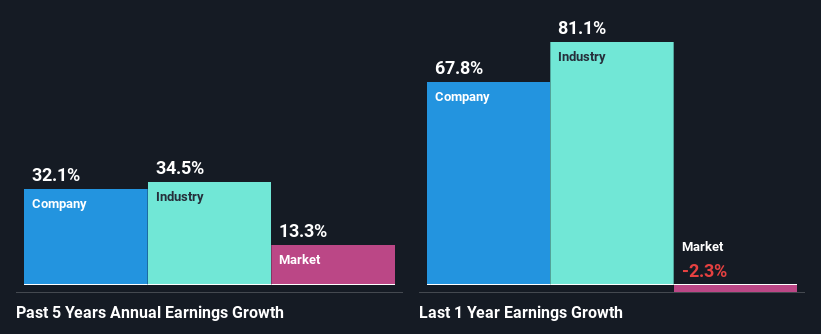Is Halliburton Company's (NYSE:HAL) Stock's Recent Performance Being Led By Its Attractive Financial Prospects?
Halliburton's (NYSE:HAL) stock is up by a considerable 20% over the past three months. Given that the market rewards strong financials in the long-term, we wonder if that is the case in this instance. Specifically, we decided to study Halliburton's ROE in this article.
Return on equity or ROE is an important factor to be considered by a shareholder because it tells them how effectively their capital is being reinvested. In short, ROE shows the profit each dollar generates with respect to its shareholder investments.
View our latest analysis for Halliburton
How To Calculate Return On Equity?
The formula for ROE is:
Return on Equity = Net Profit (from continuing operations) ÷ Shareholders' Equity
So, based on the above formula, the ROE for Halliburton is:
28% = US$2.7b ÷ US$9.4b (Based on the trailing twelve months to December 2023).
The 'return' refers to a company's earnings over the last year. That means that for every $1 worth of shareholders' equity, the company generated $0.28 in profit.
What Is The Relationship Between ROE And Earnings Growth?
We have already established that ROE serves as an efficient profit-generating gauge for a company's future earnings. Based on how much of its profits the company chooses to reinvest or "retain", we are then able to evaluate a company's future ability to generate profits. Generally speaking, other things being equal, firms with a high return on equity and profit retention, have a higher growth rate than firms that don’t share these attributes.
Halliburton's Earnings Growth And 28% ROE
To begin with, Halliburton has a pretty high ROE which is interesting. Secondly, even when compared to the industry average of 16% the company's ROE is quite impressive. As a result, Halliburton's exceptional 32% net income growth seen over the past five years, doesn't come as a surprise.
As a next step, we compared Halliburton's net income growth with the industry and found that the company has a similar growth figure when compared with the industry average growth rate of 35% in the same period.
Earnings growth is an important metric to consider when valuing a stock. The investor should try to establish if the expected growth or decline in earnings, whichever the case may be, is priced in. By doing so, they will have an idea if the stock is headed into clear blue waters or if swampy waters await. Has the market priced in the future outlook for HAL? You can find out in our latest intrinsic value infographic research report.
Is Halliburton Using Its Retained Earnings Effectively?
Halliburton has a really low three-year median payout ratio of 21%, meaning that it has the remaining 79% left over to reinvest into its business. So it looks like Halliburton is reinvesting profits heavily to grow its business, which shows in its earnings growth.
Besides, Halliburton has been paying dividends for at least ten years or more. This shows that the company is committed to sharing profits with its shareholders. Our latest analyst data shows that the future payout ratio of the company over the next three years is expected to be approximately 19%. Therefore, the company's future ROE is also not expected to change by much with analysts predicting an ROE of 26%.
Summary
In total, we are pretty happy with Halliburton's performance. In particular, it's great to see that the company is investing heavily into its business and along with a high rate of return, that has resulted in a sizeable growth in its earnings. That being so, a study of the latest analyst forecasts show that the company is expected to see a slowdown in its future earnings growth. To know more about the company's future earnings growth forecasts take a look at this free report on analyst forecasts for the company to find out more.
Have feedback on this article? Concerned about the content? Get in touch with us directly. Alternatively, email editorial-team (at) simplywallst.com.
This article by Simply Wall St is general in nature. We provide commentary based on historical data and analyst forecasts only using an unbiased methodology and our articles are not intended to be financial advice. It does not constitute a recommendation to buy or sell any stock, and does not take account of your objectives, or your financial situation. We aim to bring you long-term focused analysis driven by fundamental data. Note that our analysis may not factor in the latest price-sensitive company announcements or qualitative material. Simply Wall St has no position in any stocks mentioned.

 Yahoo Finance
Yahoo Finance 
